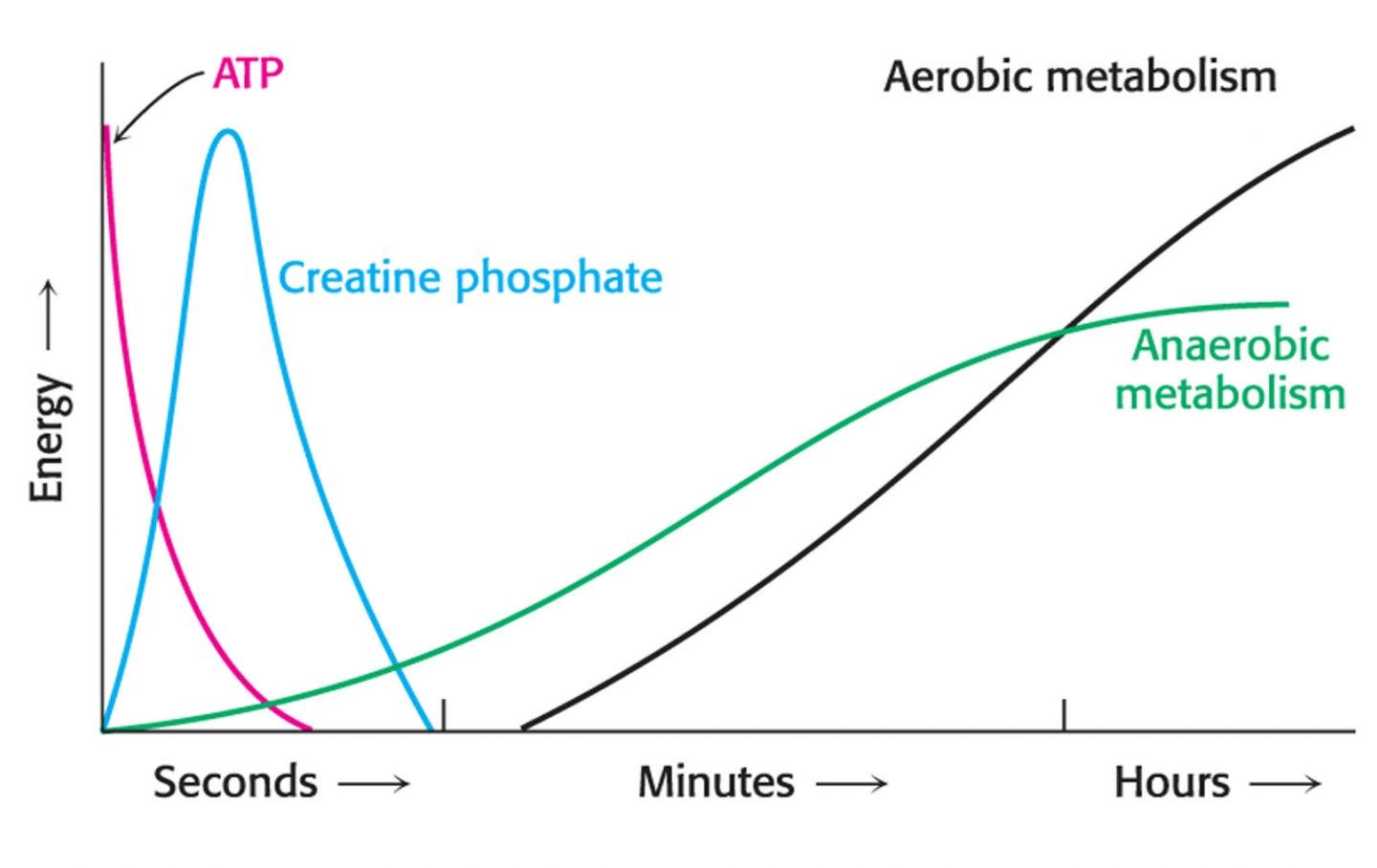Creating a Workout for ANY Goal: The Intensity Spectrum
Welcome to The Spotter!
I am Nolan Vannata. This newsletter is a part of my mission to make health, fitness, and nutrition content that is evidence-based, digestible, practical, and accessible.
As intensity goes up, maximal duration goes down. As duration goes up, maximal intensity goes down.
You already know this, even if you think you don’t.
If I told you to run 100 meters, 1 mile, and a marathon as fast as possible, you would run a faster pace for the shorter distances and a slower pace for the longer distances even though they are all performed at a maximum effort. The same applies for resistance training. You can do more knee push-ups than you can regular push-ups because the intensity of the regular push-up is higher than that of the knee push-up.
Intensity has a different meaning in exercise science and is commonly mistaken as a way to describe how difficult something is. Instead, exercise intensity should be seen as how close something is to your maximal output regardless of acute fatigue. Running 100 miles is extremely difficult, but the intensity is quite low. Jumping as high as you can one time isn’t too fatiguing, but the intensity is very high.
Different intensities elicit different adaptations
Again, you probably know this on some level. Body builders, sprinters, figure skaters, and cyclists train drastically different because they want different results from their training. Depending on your specific goals, you might need to train at different intensities.
In the figure below, you can see that we rely on different energy systems depending on the duration of an exercise task. For very short durations, we use stored ATP and creatine phosphate for energy. This is why creatine supplementation is beneficial for strength and power training. You can read more about creatine in my previous article, Creatine 101. As duration increases, you start to use the glycolytic system. This is heavily reliant on carbohydrates for fuel and results in that traditional “burn” feeling in your muscles. As duration continues to increase, you rely more on aerobic metabolism, using oxygen to turn fats and carbohydrates into energy.
While aerobic metabolism is very efficient, is has lower maximal production. On the other hand, the creatine phosphate system can produce a lot of energy but runs out within seconds. The glycolytic system falls somewhere in the middle.
Understanding the intensity spectrum will help you make workouts that are specific to your goals.
I will outline the different parts of the intensity spectrum, give some example exercises/workouts, and tell you exactly what kind of benefits you get by training at those intensities.
From high intensity to low intensity, I will discuss the following types of training:
Speed and power
Strength
Local muscular endurance
Suprathreshold or VO2 max
Threshold
Sub threshold
Speed and power training
Speed and power training is not reserved for athletes. These short-duration, high intensity exercises can benefit anyone. Examples of speed and power training include things like sprinting, jumping, and explosive weight training.
Example speed and power sets
4 sets of 10 second hill sprints
3 sets of 3 box jumps
3 sets of 4 back squats, using 40% of maximal weight, coming up as fast as possible
3 sets of 4 medicine ball throws
Speed and power exercises usually have generous rest periods with at least a minute in between sets, but usually two to five minutes.
How does this benefit you?
Speed and power exercises improve the nervous system’s ability to recruit muscle tissue. According to the article, “Skeletal Muscle Power: A Critical Determinant of Physical Functioning In Older Adults”, muscular power declines earlier and more rapidly than muscular strength, and muscle strength declines more than muscle size. In other words, for every unit of muscle mass lost with age, you lose an even larger amount of strength and an even larger amount of power.
Speed and power exercises also improve muscle-tendon stiffness. While a “stiff” muscle sounds bad, it is actually a very beneficial adaptation to this type of training and shouldn’t be confused with a “tight” muscle. Muscle-tendon stiffness is responsible for muscle “springiness” that helps facilitate efficient movement.
Strength training
Strength training involves lifting close-to-maximal weights, usually for one to ten reps, although there are likely specific circumstances in which you can call a set of more than ten reps a proper strength set. Either way, the weight needs to be heavy.
Example strength sets
3 sets of 6 bench press
5 sets of 3 back squat
4 sets of 5 pull-ups
Like speed and power training, strength training usually has generous rest periods in between sets, anywhere from one to five minutes depending on the difficulty of the exercises.
How does this benefit you?
Strength exercise is great for improving the size AND function of your muscles. Also, strength training is extremely effective for improving bone density, which I wrote about in a previous article.
Local muscular endurance training
I like to think of this as resistance training in the 10-30 rep range. You could make an argument for a set of 8 or 40, but you get the point.
Example workouts/sets
4 sets of 15 push-ups
3 sets of 12 leg press
5 sets of 20 cable rows
Rest periods for this type of work are usually anywhere from one to three minutes depending on the difficulty of the working set.
How does this benefit you?
Training at this intensity allows you to build up muscular endurance (hence, the name), but it is also a common intensity used by those looking to increase their muscle mass.
Heavy strength training can be just as effective for building muscle mass, but it is fatiguing and potentially dangerous to always lift extremely heavy weights. If increasing muscle mass is a top priority of yours, I recommend leaning into local muscular endurance training.
As discussed in my previous article, How to Maximize Muscle Growth, Part 1: Exercise, muscle mass has a strong positive correlation with increased quality of life and life span.
Suprathreshold/VO2max training
This is now considered aerobic training. By “suprathreshold” I mean moving at constant paces or power outputs where lactic acid and oxygen consumption continuously rise, even though you aren’t going any faster with time. Thus, you are above your threshold. Go for long enough and you eventually reach what is called your VO2 max (i.e. maximum volume of oxygen). Your VO2 max is the highest amount of oxygen consumption you can achieve.
Example suprathreshold/VO2max workouts
8 x 2 minutes of work, 2 minutes of rest in between
4 x 4 minutes of work, 4 minutes of rest in between
30 x 30 seconds of work, 30 seconds of rest in between.
These workouts are usually performed by resting for the same duration as the working interval, although that isn’t always the case. These are also extremely difficult, and you will definitely feel like you are breathing as much oxygen as possible while doing them. Any exercise that uses a lot of different muscles will be effective for this, like cycling, running, swimming, rowing, etc.
How does this benefit you?
VO2 max has a strong positive correlation with life span. According to the study, “Cardiorespiratory Fitness as a Quantitative Predictor of All-Cause Mortality and Cardiovascular Events in Healthy Men and Women”, you reduce your all-cause mortality risk by 13-15% for every VO2 max increase of 3.5mL/kg/min. For reference, the average VO2 max for middle-aged men is in the mid-30s, and for women is in the low-30s. By this math, increasing an average VO2 max by 10% will reduce your all-cause mortality by 13-15%.
While these workouts can be difficult, the good news is you don’t have to do them that often. Once per week is likely enough for most people to see a significant improvement, although you could do them two or three times per week if VO2 max is currently a high priority.
Threshold training
Threshold training is another type of aerobic exercise. If you are an endurance athlete, my definition might seem like an over-simplification, but you are training at “threshold” when you have a significant increase in respiratory rate and lactate levels, but it is still sustainable. Not too fast or slow, and not too hard or easy. The goldilocks zone.
Example threshold workouts
3 x 10 minutes moderately hard with 3 minutes rest in between each interval
5 x 8 minutes moderately hard with 3 minutes rest in between each interval
2 x 20 minutes moderately hard with 5 minutes rest in between each interval
“Moderately hard” can mean different things depending on your fitness level and the length of the interval. In general, these should be done at an effort level of a 7 or 8 out of 10. To learn more about RPE and using effort to guide your training, check out my previous article.
How does this benefit you?
According to the book, Scientific Training for Endurance Athletes, by Dr. Skiba, this type of training is great for maximizing metabolic fitness. This type of training results in a mix of adaptations also seen in suprathreshold and sub threshold training, which makes sense as it is in between those two.
Subthreshold training
You may have heard this intensity referred to this as “zone 2”. Zone 2 training has become increasingly popular over the past several years. I am personally not a fan of this phrase as there is no clear distinction between zone 1 and zone 2. Therefore, I prefer to call it low intensity or subthreshold training. This low intensity style of training is useful because the intensity is so low that you are capable of doing it for very long durations.
Example subthreshold workouts
30 minutes of walking
45 minutes on the rower
4-hour bike ride
Go at an easy sustained pace for a long period of time. Not so easy that it feels like nothing, but you should be able to sustain a conversation with a friend without gasping for air in between sentences.
How does this benefit you?
There are several benefits to training at this intensity. Like all forms of aerobic training, it is great for improving your cardiovascular fitness and metabolic health. However, subthreshold training holds two unique benefits I like to highlight.
First of all, it is relatively easy and lacks the same intimidation factor as other exercises. Of course, it still requires work, but you generally don’t have to “dig deep” to get through these workouts.
Second, the recovery cost of subthreshold training is extremely low, making this training a great workout to sprinkle in between your other workouts that might done at higher intensities.
Summary
All of these intensities provide their own unique benefits, but with some overlap. What they do share is that they can all improve your quality of life, especially at older ages where physical fitness starts to decline more rapidly.
If you can hike up mountains with relative ease but don’t have a lot of muscle mass and aren’t capable of lifting heavy things, I advise doing some strength training. If you are strong as an ox but can’t run or walk a mile without gasping for air, start incorporating some aerobic training workouts I discussed above.
What's next? What Your Watch Can and Can’t Tell You.
Skip the learning curve, get a coach.
You deserve more than fad diets and one-size-fits-all fitness programs. If you need help with your fitness, nutrition, or both, schedule a FREE call with me by clicking this link. Use this call to ask any questions and learn how online coaching works.
Not ready? Visit thespottercoaching.com for more information.




So thorough! I see people at the gym resting between sets upwards of ten minutes, monopolizing the equipment. One to three minutes is more like it!